"The problem for engineers is that change translates into chaos, especially
when a single error can potentially bring down an entire system. But,
change also translates into opportunity. It's as simple as this: if there
is time to put a certain amount of functionality into the product easily,
then there is time to put in more functionality at the price of a certain
amount of disruption and risk. Thus does madness creep into our projects
- we will tend to take on as much risk as we possibly can."
"工程师所面临的问题是修改软件会引起系统混乱,特别是一个微小的错误就能导致系统崩溃。但是,修改也能带来机遇。简而言之:如果很轻易地就能给系统增加一定功能,那么就会冒一定的风险增加更多的功能。从而使我们的计划显得有些疯狂-我们将倾向于尽可能地冒风险。"
James Bach. October 1995. "American Programmer"
Copyright 1995 Advanced Development Methods All Rights Reserved
--------------------------------------------------------------------------------
Contents :
Introduction
简介
Overview
概述
Current Development Situation
现在的发展状况
Methodology
方法
Phases
进度
Controls
控制
Deliverables
可交付性
Project Team
项目组
Characteristics
特性
Advantages
优势
Estimating
评估
Appendix 1 - System Development Methodologies : Defined or Empirical
附录1-系统开发方法:定义或经验
--------------------------------------------------------------------------------
Introduction
简介
In this paper we introduce a development process, SCRUM, that
treats major portions of systems development as a controlled black box.
We relate this to complexity theory to show why this approach increases
flexibility and ability to deal with complexity, and produces a system
that is responsive to both initial and additionally occurring requirements.
在本章中,我们将介绍一种新的开发过程-SCRUM,它将系统开发的主要部分看成一个可控制的黑盒。我们将之与复杂性理论相联系,来说明为什么这种方法改善了适应性和处理复杂问题的能力,并能建立一种适应初始的和额外的需求的系统。
Numerous approaches to improving the systems development process have
been tried. Each has been touted as providing "significant productivity
improvements." None has. As Grady Booch noted, "We often call this condition
the software crisis, but frankly, a malady that has carried on this long
must be called normal."
人们已经提出许多改进系统开发过程的方法。每一种方法都被吹捧为:"重大成果性突破。"其实没有一种做到。正如Grady Booch所说的:"我们常称这种情况为软件危机,但坦率的说,长久以来我们一直把这种病态看作是正常的。
Concepts from industrial process control are applied to the field of systems
development in this paper. Industrial process control defines processes
as either "theoretical" (fully defined) or "empirical" (black box). When
a black box process is treated as a fully defined process, unpredictable
results occur. A further treatment of this is provided in Appendix 1.
在这篇文章中,工业过程控制的观点应用到系统开发领域。工业过程控制定义过程或者是"理论的"(完全定义的)或者是"经验的"(黑盒)。当将一个黑盒过程当作完全定义的过程处理时,会发生不可预测的结果。对这种情况进一步的处理将在附录1中给出。
A significant number of systems development processes are not completely
defined, but are treated as though they are. Unpredictability without
control results. The SCRUM approach treats these systems development processes
as a controlled black box.
许多大型的系统开发过程是非完全定义的,但却当作完全定义的来处理。这就导致了无控制的不可预知性。SCRUM方法在处理系统开发过程时将其看作可控制的黑盒。
The SCRUM approach is used at leading edge software companies with significant
success. We believe SCRUM may be appropriate for other software development
organizations to realize the expected benefits from Object Oriented techniques
and tools.
SCRUM方法现在被很多领先的软件公司成功使用。我们相信SCRUM将会适用于其他的软件开发机构以实现面向对象的技术与工具所期望带来的利益。
--------------------------------------------------------------------------------
Overview
概述
Our new approach to systems development is based on both defined
and black box process management. We call the approach the SCRUM methodology,
after the SCRUM in rugby -- a group responsible for picking up the ball
and moving it forward.
我们的系统开发的新方法是基于定义的和黑箱过程管理的。我们借用橄榄球中的SCRUM并称这种方法为SCRUM方法论――一个团队负责拿球向前冲。
SCRUM is a management, enhancement and maintenance methodology for an
existing system. SCRUM will address new or re-engineered systems development
efforts at a later date.
SCRUM是一种对已存在系统的管理,提高和维护的方法。在不久的将来,SCRUM将致力于新的或重组的系统开发。
Software product releases are planned based on the following variables
:
软件产品的发布是基于以下因素制定的:
Customer requirements - how the current system needs enhancing.
客户需求-现在的系统需要那些改进。
Time pressure - what time frame is required to gain a competitive advantage.
时间压力-需要什么样的时间表以获得竞争优势。
Competition - what is the competition up to, and what is required to best
them.
竞争-竞争的目标是什么,如何最好地实现目标
Quality - What is the required quality, given the above variables.
质量-有了以上的因素,那么需要什么样的质量。
Vision - what changes are required at this stage to fulfill the system
vision.
版本-当前需要什么样的更改以完成系统版本。
Resource - what staff and funding are available.
资源-有多少可用的资金和员工。
These variables form the initial plan for a software enhancement project.
However, these variables also change during the project. A successful
development methodology must take these variables and their evolutionary
nature into account.
这些因素形成了改进软件项目的最初方案。然而,这些因素是随着项目的进行而变化的。一个成功的开发方法应该将这些因素现在及其将来可能的变化都考虑进去。
--------------------------------------------------------------------------------
Current Development Situation
当前开发情况
Systems are developed in a highly complicated environment.
The complexity is both within the development environment and the target
environment. For example, when the air traffic control system development
was initiated, three-tier client server systems and airline deregulation
did not have to be considered. Yet, these environmental and technical
changes occurred during the project and had to be taken into account within
the system being built. Environmental variables include:
系统是在一个高度复杂的环境下开发的。复杂性同时存在于开发环境和目标环境。例如,当开始开发航空交通控制系统时,三层客户-服务器系统及航线异常情况并没有被考虑在内。然而,这些环境和技术变化通常会发生在项目进行过程中,你不得不在正在构建的系统中考虑到这些因素。环境因素包括:
Availability of skilled professionals - the newer the technology, tools,
methods, and domain, the smaller the pool of skilled professionals.是否有足够的熟练专业人员——技术、工具、方法、领域越新,相应的熟练专业人员就越少。
Stability of implementation technology - the newer the technology, the
lower the stability and the greater the need to balance the technology
with other technologies and manual procedures. 实现技术的稳定性——对于越新的技术,稳定性可能就越低,并且更需要去平衡该技术及其它技术和人工程序的关系。
Stability and power of tools - the newer and more powerful the development
tool, the smaller the pool of skilled professionals and the more unstable
the tool functionality. 稳定性和工具的性能——越是新的和功能强大的开发工具,就拥有更少的熟练开发人员,并且它的功能上的稳定性就越差。
Effectiveness of methods - what modeling, testing, version control, and
design methods are going to be used, and how effective, efficient, and
proven are they. 方法的有效性——将使用什么样的建模、测试、版本控制及设计方法,他们的效率怎样?是否有足够的保证?
Domain expertise - are skilled professionals available in the various
domains, including business and technology.行业知识和经验——是否有不同行业(包括商业和技术方面)的专业人才?
New features - what entirely new features are going to be added, and to
what degree will these fit with current functionality. 新特性——将添加什么样的新特性,这些新特性将在什么样的程度上符合当前的功能。
Methodology - does the overall approach to developing systems and using
the selected methods promote flexibility, or is this a rigid, detailed
approach that restricts flexibility. 方法学——用于开发系统的途径和所选择的方法是提升系统的适应性还是限制了系统的适应性?
Competition - what will the competition do during the project? What new
functionality will be announced or released. 竞争性——在项目进行过程中,将怎样提高竞争性?将宣布或发布什么新功能?
Time/Funding - how much time is available initially and as the project
progresses? How much development funding is available.时间/资金——在项目启动和进展过程中,有多少时间可用?有多少开发经费可支配?
Other variables - any other factors that must be responded to during the
project to ensure the success of the resulting, delivered system, such
as reorganizations. 其它因素——项目进行过程中,为确保成功,任何其它因素都必须考虑,如机构重组。
The overall complexity is a function of these variables :
整体的复杂性可以用这些因素的一个函数来表示:
complexity = f(development environment variables + target environment
variables)
复杂度=f(开发环境因素+目标环境因素)
where these variables may and do change during the course of the project.
其中,这些因素可能而且确实会在项目过程中变化。
As the complexity of the project increases, the greater the need for controls,
particularly the ongoing assessment and response to risk.
随着项目的复杂度增加,就更需要控制,特别是资产评估和风险反应。
Attempts to model this development process have encountered the following
problems:
对这类开发过程的建模尝试已经遇到下列问题:
Many of the development processes are uncontrolled. The inputs and outputs
are either unknown or loosely defined, the transformation process lacks
necessary precision, and quality control is not defined. Testing processes
are an example.
许多开发过程是未加以控制的。输入输出都是未知的或仅仅初略定义的,过程转换缺少必要的精确性,并且质量控制也是未定义的。测试过程就是一个样例。
An unknown number of development processes that bridge known but uncontrolled
processes are unidentified. Detailed processes to ensure that a logical
model contains adequate content to lead to a successful physical model
is one such process.
那些在已知的但未经控制的过程之间尚有未知数量的开发过程未被确认。用于确保包含足够内容的逻辑模型过渡到成功的物理模型的分过程就是这样一种过程。
Environmental input (requirements) can only be taken into consideration
at the beginning of the process. Complex change management procedures
are required thereafter.
环境输入(需求)只能在过程的初始考虑。之后就需要复杂的变化管理程序。
Attempts to impose a micro, or detailed, methodology model on the development
process have not worked because the development process is still not completely
defined. Acting as though the development process is defined and predictable
results in being unprepared for the unpredictable results.
在开发过程中使用小的、详细的方法模型的尝试还未实现过,因为开发过程仍未完全定义。自以为开发过程是定义了的和可预知的,将会导致真正面对不可预知的结果时束手无策。
Although the development process is incompletely defined and dynamic,
numerous organizations have developed detailed development methodologies
that include current development methods (structured, OO, etc.). The Waterfall
methodology was one of the first such defined system development processes.
A picture of the Waterfall methodology is shown in Figure 1.
尽管开发过程是未完全定义的和动态的,众多的机构已经制定出详细的开发方法,包括流行的开发方法(结构化的方法,面向对象的方法,等等)。瀑布式方法是其中第一个这样被定义的系统开发过程。
见图1。
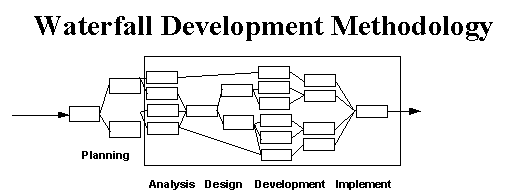
图 1
Although the waterfall approach mandates the use of undefined processes,
its linear nature has been its largest problem. The process does not define
how to respond to unexpected output from any of the intermediate process.
虽然瀑布式方法管理了未定义过程的使用,但是,它的线性特点成为它的最大问题。这种过程没有定义如何响应任何中间过程的不可预知的输出。
Barry Boehm introduced a Spiral methodology to address this problem. Each
of the waterfall phases is ended with a risk assessment and prototyping
activity. The Spiral methodology is shown in Figure 2.
Barry Boehm 引入了一个螺旋型方法来解决这个问题。瀑布式过程的每个阶段都用一个风险评估和原型活动来结束。 见图2.
The Spiral methodology "peels the onion", progressing through "layers"
of the development process. A prototype lets users determine if the project
is on track, should be sent back to prior phases, or should be ended.
However, the phases and phase processes are still linear. Requirements
work is still performed in the requirements phase, design work in the
design phase, and so forth, with each of the phases consisting of linear,
explicitly defined processes.
螺旋型方法就象剥洋葱一样,在开发过程中的阶梯式前进。原型让用户决定项目是否继续进行下去,或者是需要送回到前一个阶段,还是应该结束。然而,阶段和阶段过程仍然是线性的。需求分析仍然在需求分析阶段处理,设计工作仍然在设计阶段进行,如此类推,每个阶段包含线性的、定义明确的过程。
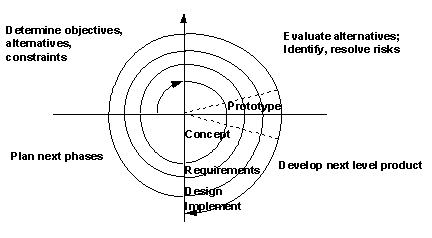
图 2
The Iterative methodology improves on the Spiral methodology. Each iteration
consists of all of the standard Waterfall phases, but each iteration only
addresses one set of parsed functionality. The overall project deliverable
has been partitioned into prioritized subsystems, each with clean interfaces.
Using this approach, one can test the feasibility of a subsystem and technology
in the initial iterations. Further iterations can add resources to the
project while ramping up the speed of delivery. This approach improves
cost control, ensures delivery of systems (albeit subsystems), and improves
overall flexibility. However, the Iterative approach still expects that
the underlying development processes are defined and linear. See Figure
3.
迭代方法是在螺旋型方法之上发展而来的。每个迭代过程包含所有的标准瀑布式阶段,但每个迭代过程只处理解析过的功能的一个子集。整个可交付的项目被细分为区分优先级的子系统,每个子系统都有清楚的接口。使用这种方法,可以在初始迭代过程中测试一个子系统和技术的可行性。进一步的迭代能给项目添加新的资源,同时保持交付的速度。这种方法改善费用控制,确保系统(尽管是子系统)的交付,并且改善整体的适应性。然而,迭代方法仍然要求其中的开发过程是定义的和线性的。见图3。
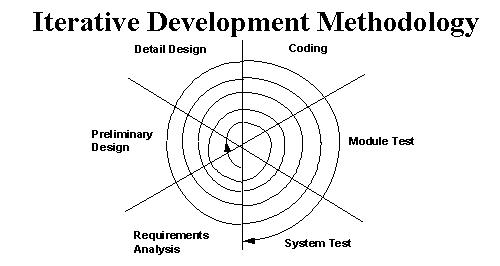
图 3
Given the complex environment and the increased reliance on new "state-of-the-art"
systems, the risk endured by system development projects has increased
and the search for mechanisms to handle this risk has intensified. One
can argue that current methodologies are better than nothing. Each improves
on the other. The Spiral and Iterative approaches implant formal risk
control mechanisms for dealing with unpredictable results. A framework
for development is provided.
在复杂的环境及对新的“时髦”系统的更多依赖的情况下,系统开发项目所要承担的风险已经加大,进一步加深了对能处理风险的机制的需求。人们可以对使用当前的方法是否比什么方法也不用更好提出质疑。每一种方法都是对另一种方法的改进。螺旋型方法和迭代方法灌输正规的用于处理不可预知的结果的风险控制机制。它们提供一个开发框架。
However, each rests on the fallacy that the development processes are
defined, predictable processes. But unpredictable results occur throughout
the projects. The rigor implied in the development processes stifles the
flexibility needed to cope with the unpredictable results and respond
to a complex environment.
然而,它们都取决于一个谬论:开发过程是定义的,可预知的。事实是不可预知的结果在整个项目过程中都可能发生。开发过程的严密,抑制了应付未知结果及响应复杂环境的适应性,
Despite their widespread presence in the development community, people
don't use the methodologies except as a macro process map, or for their
detailed method descriptions.
尽管这些开发方法已经在开发团体中普遍使用,许多人只用它们作为宏观的过程图象,或者是详细的方法描述。
The following graph demonstrates the current development environment,
using any of the Waterfall, Spiral or Iterative processes. As the complexity
of the variables increase even to a moderate level, the probability of
a "successful" project quickly diminishes (a successful project is defined
as a system that is useful when delivered). See Figure 4.
下面的图片使用瀑布式方法、螺旋型方法或迭代过程中的任何一种方法来描述当前开发环境。当系统因素的复杂度增加到中等的程度,项目成功的可能性就迅速减少(成功的项目是指交付时有用的系统)。
见图4。
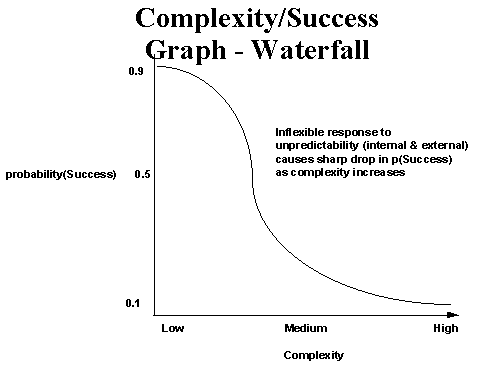
图 4
--------------------------------------------------------------------------------
Methodology
方法
The system development process is complicated and complex.
Therefore maximum flexibility and appropriate control is required. Evolution
favors those that operate with maximum exposure to environmental change
and have maximized flexibility. Evolution deselects those who have insulated
themselves from environmental change and have minimized chaos and complexity
in their environment.
系统开发过程是复杂的和综合的,所以需要拥有最大化的适应性和进行恰当的控制。进化的过程喜欢把把环境的改变最大限度地暴露出来,不喜欢将自己和环境的改变隔离,以及将环境的复杂性最小化的行为。
An approach is needed that enables development teams to operate adaptively
within a complex environment using imprecise processes. Complex system
development occurs under chaotic circumstances. Producing orderly systems
under chaotic circumstances requires maximum flexibility. The closer the
development team operates to the edge of chaos, the more competitive and
useful the resulting system will be.
需要一种允许开发小组在复杂的环境中以非精确的步骤进行开发的方法。复杂的系统开发发生于混乱的系统环境中。在混乱的环境中有序地进行开发,需要开发团队有最大的适应性。越靠近混乱的边缘进行开发的团队,越容易开发出具有竞争力和有实用价值的系统。
Methodology may well be the most important factor in determining the probability
of success. Methodologies that encourage and support flexibility have
a high degree of tolerance for changes in other variables. With these
methodologies, the development process is regarded as unpredictable at
the onset, and control mechanisms are put in place to manage the unpredictability.
方法学可能说是检测软件是否成功的最重要的因素。方法学鼓励和支持软件开发对环境变化拥有很高的调整能力。在这些方法学中,开发过程被认为在开始时是不可预知的,而控制机制正是用来管理不可预知性。
If we graph the relationship between environmental complexity and probability
of success with a flexible methodology that incorporates controls and
risk management, the tolerance for change is more durable. See Figure
5.
如果我们画一个关系图,用来表示环境复杂性和的项目成功的概率之间的关系,这里的项目是指应用了统一控制和风险管理的可适应方法论的项目。参见图5。
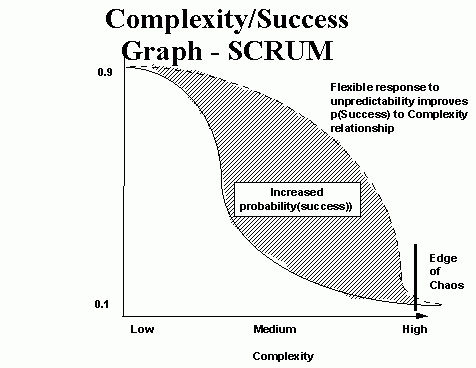
图 5
Figures 4 and 5 reflect software development experiences at ADM, Easel,
Vmark, Borland and virtually every other developer of "packaged" software.
These organizations have embraced risk and environmental complexity during
development projects. Increased product impact, successful projects, and
productivity gains were experienced. The best possible software is built.
图4和图5反映出ADM,Easel,Vmark,Borland以及事实上每一个其他的打包软件的开发者软件开发的经验。这些机构也都在开发项目时遇到风险和复杂的环境。他们经历了产品不断需要增强的影响,项目的成功,生产力的不断提高。这样最好的软件诞生了。
Waterfall and Spiral methodologies set the context and deliverable definition
at the start of a project. SCRUM and Iterative methodologies initially
plan the context and broad deliverable definition, and then evolve the
deliverable during the project based on the environment. SCRUM acknowledges
that the underlying development processes are incompletely defined and
uses control mechanisms to improve flexibility.
瀑布和螺旋模型在项目开始时声明前后关系和可交付定义。SCRUM和迭代的方法在开始时定义前后关系和主要的可交付定义,以后在根据项目环境增加可交付定义。SCRUM承认根本的开发过程不能完全加以定义,需要用控制机制增加可行性。
The primary difference between the defined (waterfall, spiral and iterative)
and empirical (SCRUM) approach is that The SCRUM approach assumes that
the analysis, design, and development processes in the Sprint phase are
unpredictable. A control mechanism is used to manage the unpredictability
and control the risk. Flexibility, responsiveness, and reliability are
the results. See Figure 6.
在瀑布、螺旋、迭代等模型的已定义方法和经验主义的SCRUM方法之间的基本不同点是SCRUM方法假定在快速变化中分析、设计、开发过程中的状态是不可预知的。一种控制机制被用于管理不可预知性和控制风险。带来的成效是适应性、响应能力和可靠性的增强。见图6
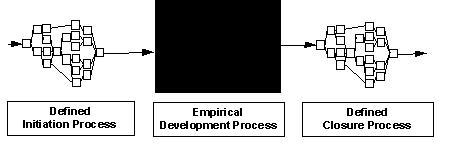
图 6
Characteristics of SCRUM methodology are :
SCRUM方法的特征如下:
The first and last phases (Planning and Closure) consist of defined processes,
where all processes, inputs and outputs are well defined. The knowledge
of how to do these processes is explicit. The flow is linear, with some
iterations in the planning phase.
最先和最后阶段(计划阶段和结束阶段)由可定义的过程组成,这些过程的输入输出都能很好的加以定义。如何去实施这些过程的知识是很明确的。过程流程是直线的,在计划阶段会有一些迭代。
The Sprint phase is an empirical process. Many of the processes in the
sprint phase are unidentified or uncontrolled. It is treated as a black
box that requires external controls. Accordingly, controls, including
risk management, are put on each iteration of the Sprint phase to avoid
chaos while maximizing flexibility.
冲刺阶段是一个完全根据经验的过程。在冲刺阶段中的许多的过程是未经确认地和不可控制的。可以视为需要额外控制的黑盒。因此包括风险管理的控制被放在冲刺阶段的每一次迭代,以避免在取得最佳的适应性的同时造成混乱。
Sprints are nonlinear and flexible. Where available, explicit process
knowledge is used; otherwise tacit knowledge and trial and error is used
to build process knowledge. Sprints are used to evolve the final product.
冲刺过程是非线性的和可变的。如果有明确的过程知识,就用它来建立过程知识,否则就使用默认的知识以及试验的以及错误的知识。冲刺过程被用于发展最终产品。
The project is open to the environment until the Closure phase. The deliverable
can be changed at any time during the Planning and Sprint phases of the
project. The project remains open to environmental complexity, including
competitive, time, quality, and financial pressures, throughout these
phases.
项目是对环境开放的,直到项目结束阶段。在项目的计划阶段和冲刺阶段,可交付信息可以在任何时间被改变。在这些状态中,项目始终保持对复杂的环境的开放,包括竞争,时间,质量和资金压力。
The deliverable is determined during the project based on the environment.
可交付内容由项目的环境所决定。
Figure 7 compares the primary SCRUM characteristics to those of other
methodologies.
图7基本的SCRUM方法和其他方法特性的比较
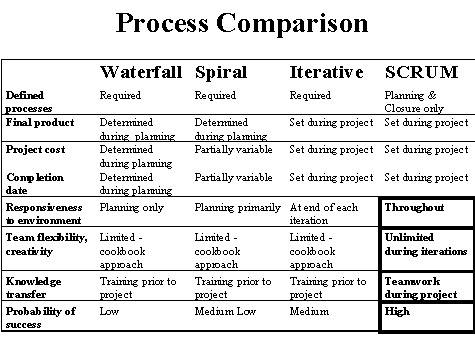
图 7
--------------------------------------------------------------------------------
Phases
进度
Pregame
项目开始前
Planning : Definition of a new release based on currently known backlog,
along with an estimate of its schedule and cost. If a new system is being
developed, this phase consists of both conceptualization and analysis.
If an existing system is being enhanced, this phase consists of limited
analysis.
计划阶段:在当前已知的待定项的基础上,对新版本进行定义,并预计其进度和费用。如果正在开发一个新的系统,本阶段包含概念化和分析两方面;如果正在对现有系统进行增强,则本阶段仅包含有限的分析。
Architecture : Design how the backlog items will be implemented. This
phase includes system architecture modification and high level design.
体系架构阶段:构思如何实现待定项。本阶段包括系统架构修改和高层设计。
Game
项目中
Development Sprints : Development of new release functionality, with constant
respect to the variables of time, requirements, quality, cost, and competition.
Interaction with these variables defines the end of this phase. There
are multiple, iterative development sprints, or cycles, that are used
to evolve the system.
开发冲刺阶段:在始终考虑时间、需求、质量、费用和竞争等因素的情况下,开发新版本的功能。与上述因素间的相互作用标志着本阶段的完成。为了提升系统性能,会有多次的、迭代的开发冲刺或循环。
Postgame
项目结束后
Closure : Preparation for release, including final documentation, pre-release
staged testing, and release.
结束阶段:版本发布准备,包括准备最终文档、发行前的阶段性测试以及最终版本。
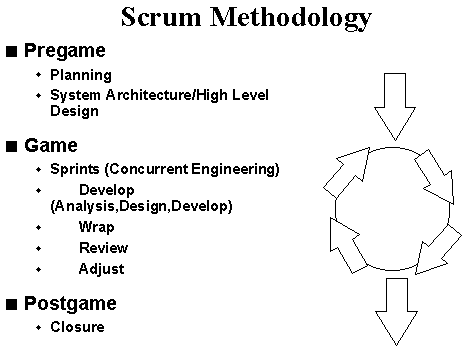
图 9
Each of the phases has the following steps:
每一阶段均包含以下步骤:
Planning
计划
Development of a comprehensive backlog list.
形成一个全面的待定项的目录
Definition of the delivery date and functionality of one or more releases.
确定发行日期及一个或多个发行版本的功能
Selection of the release most appropriate for immediate development.
为后继开发选择一个最合适的版本。
Mapping of product packets (objects) for backlog items in the selected
release.
在选定的版本中,为待定项和产品包(对象)间建立对应关系。
Definition of project team(s) for the building of the new release.
为新版本的开发确定各项目小组。
Assessment of risk and appropriate risk controls.
进行风险评估,并加以适当的风险控制。
Review and possible adjustment of backlog items and packets.
对待定项和程序包进行总结及可能的调整。
Validation or reselection of development tools and infrastructure.
对开发工具和基础架构进行确认或重新选择。
Estimation of release cost, including development, collateral material,
marketing, training, and rollout.
预测发行成本,包括开发、相关材料、市场营销、培训和首次展示。
Verification of management approval and funding.
确认经理的认可和资金保障。
Architecture/High Level Design
架构/高层设计
Review assigned backlog items.
总结已指派的待定项。
Identify changes necessary to implement backlog items.
确定为实现待定项所必须的变化。
Perform domain analysis to the extent required to build, enhance, or update
the domain models to reflect the new system context and requirements.
进行域分析,直至新的系统环境和需求需要建立、增强和更新现有域模型为止。
Refine the system architecture to support the new context and requirements.
精化系统架构以适应新的环境和需求。
Identify any problems or issues in developing or implementing the changes
对开发和实现这些改变时所出现的各种问题和观点进行确认。
Design review meeting, each team presenting approach and changes to implement
each backlog item. Reassign changes as required.
组织总结会议,各项目小组阐明为实现各自的待定项所需的方法和变更。按需要重新分配变更。
Development (Sprint) - the Development phase is an iterative cycle of
development work. The management determines that time, competition, quality,
or functionality are met, iterations are completed and the closure phase
occurs. This approach is also known as Concurrent Engineering. Development
consists of the following macro processes :
开发(冲刺)-开发阶段是开发工作的一个迭代循环。经理判定时间、竞争性、质量或功能符合要求后,迭代过程结束并进入结束阶段。该方法也被称为并发工程。开发包含以下宏观过程:
Meeting with teams to review release plans.
与各项目小组开会讨论总结计划。
Distribution, review and adjustment of the standards with which the product
will conform.
对产品所需遵从的标准进行分发、总结和调整。
Iterative Sprints, until the product is deemed ready for distribution.
迭代冲刺,直至产品可被确认为适于发行。
A Sprint is a set of development activities conducted over a pre-defined
period, usually one or four weeks. The interval is based on product complexity,
risk assessment, and degree of oversight desired. Sprint speed and intensity
are driven by the selected duration of the Sprint. Risk is assessed continuously
and adequate risk controls and responses put in place. Each Sprint consists
of one or more teams performing the following:
一个冲刺是一系列开发活动的集合,这些开发活动贯穿预定义阶段,通常为一至四个星期。间歇期建立在产品复杂性、风险评估和预计的监管程度上。冲刺的持续时间决定了冲刺的速度和强度。风险评估是持续进行的,并应加入适当的风险控制和响应。每一冲刺由一个或多个项目小组组成来完成以下工作:
Develop: Defining changes needed for the implementation of backlog requirements
into packets, opening the packets, performing domain analysis, designing,
developing, implementing, testing, and documenting the changes. Development
consists of the micro process of discovery, invention, and implementation.
开发:对为实现待定项所需加入程序包中的变更进行定义,打开程序包,进行域分析,设计,开发,实现,测试,记录变更。开发包含发现、创新和实现的微观过程。
Wrap: Closing the packets, creating a executable version of changes and
how they implement backlog requirements.
封装:关闭程序包,为变更和这些待定需求如何实现创建一个可执行版本。
Review: All teams meeting to present work and review progress, raising
and resolving issues and problems, adding new backlog items. Risk is reviewed
and appropriate responses defined.
总结: 所有的小组开会介绍各自的工作,总结进度,提出并解决问题和困难,增加新的待定项。在会上总结风险,定义适当的风险应对策略。
Adjust: Consolidating the information gathered from the review meeting
into affected packets, including different look and feel and new properties.
调整:将从总结会议中获得的信息合并到相关程序包中,包括不同的观点、体验和新的特性。
Each Sprint is followed by a review, whose characteristics are :
每一次冲刺均伴随一次总结,其特征是:
The whole team and product management are present and participate.
整个小组和产品经理均到场参加。
The review can include customers, sales, marketing and others.
总结可包括用户、经销商、市场人员和其他人。
Review covers functional, executable systems that encompass the objects
assigned to that team and include the changes made to implement the backlog
items.
总结覆盖功能性的、可执行的系统。这些系统包含了分配给该项目小组的目标和为实现待定项所需的变更。
The way backlog items are implemented by changes may be changed based
on the review.
通过变更实现待定项的方法可在总结的基础上改变。
New backlog items may be introduced and assigned to teams as part of the
review, changing the content and direction of deliverables.
作为总结的一部分,新的待定项可被引入并分配给各项目小组,以改变可交付版本的内容和方向。
The time of the next review is determined based on progress and complexity.
The Sprints usually have a duration of 1 to 4 weeks.
下一次总结的时间由进度和复杂性确定。冲刺阶段通常持续1到4周。
Closure - When the management team feels that the variables of time, competition,
requirements, cost, and quality concur for a new release to occur, they
declare the release "closed" and enter this phase. This phase prepares
the developed product for general release. Integration, system test, user
documentation, training material preparation, and marketing material preparation
are among closure tasks.
结束:当经理综合时间、竞争性、需求、费用和质量等诸多因素,感到已经适于发布一个新的版本,他们宣布开发"结束"并进入本阶段。本阶段准备对已开发完成的产品进行常规发布。结束阶段的任务包括集成,系统测试,用户文档,培训材料和市场营销材料的准备。
--------------------------------------------------------------------------------
Controls
控制
Operating at the edge of chaos (unpredictability and complexity)
requires management controls to avoid falling into chaos. The SCRUM methodology
embodies these general, loose controls, using OO techniques for the actual
construction of deliverables.
当处于陷入混乱(未知性和复杂性)的边缘时,需要管理者进行控制避免最终陷入混乱中。在使用面向对象技术来构建实际的可发行软件过程中,SCRUM方法包括了一般化和松散的控制。
Risk is the primary control. Risk assessment leads to changes in other
controls and responses by the team.
风险是首要的控制因素,风险评估会改变对于其他内容的因素,进而带来开发团队对于这些控制因素的改变的反应。
Controls in the SCRUM methodology are :
在SCRUM方法中控制包括了下面的内容:
Backlog: Product functionality requirements that are not adequately addressed
by the current product release. Bugs, defects, customer requested enhancements,
competitive product functionality, competitive edge functionality, and
technology upgrades are backlog items.
待定项:当前版本的产品不能够充分地实现的产品功能需求、错误、缺陷、用户需求的增强、竞争性产品的功能、更优越的具有竞争性的功能以及技术升级都是待定项。
Release/Enhancement: backlog items that at a point in time represent a
viable release based on the variables of requirements, time, quality,
and competition.
版本/增强:在基于需求、时间、质量和竞争这些因素的基础上,一个可行的新版本由在某个时点上的待定项决定。
Packets: Product components or objects that must be changed to implement
a backlog item into a new release.
软件包: 为实现待定项以形成新版本而必须加以修改的产品组件或对象。
Changes: Changes that must occur to a packet to implement a backlog item.
变更:软件包必须改变从而实现待定项。
Problems: Technical problems that occur and must be solved to implement
a change.
问题:由于技术变化而出现的问题必须被解决。
Risks: risks that effect the success of the project are continuously assessed
and responses planned. Other controls are affected as a result of risk
assessment.
风险:必须不断地对影响项目成功的风险因素进行评估并且制定出对策。风险评估的结果影响了其他方面因素的控制。
Solutions: solutions to the problems and risks, often resulting in changes.
解决方案:解决困难和防范风险的解决方案通常会发生变化。
Issues: Overall project and project issues that are not defined in terms
of packets, changes and problems.
结果:整个项目和项目结果并不是由软件包、变化和问题来定义的。
These controls are used in the various phases of SCRUM. Management uses
these controls to manage backlog. Teams use these controls to manage changes,
problems. Both management and teams jointly manage issues, risks, and
solutions. These controls are reviewed, modified, and reconciled at every
Sprint review meeting.
这些控制因素存在于SCRUMf方法的不同阶段中。管理者使用这些控制因素来管理预定的项目。开发团队使用这些控制因素来解决变化和问题。管理者和开发团队共同地管理结果、风险和解决方案。在每次冲刺总结会上这些控制因素都被提出来讨论、修改并进行协调。
--------------------------------------------------------------------------------
Deliverables
可交付性
The delivered product is flexible. Its content is determined
by environment variables, including time, competition, cost, or functionality.
The deliverable determinants are market intelligence, customer contact,
and the skill of developers. Frequent adjustments to deliverable content
occur during the project in response to environment. The deliverable can
be determined anytime during the project.
交付的产品是可变的。具体内容取决于包括时间、竞争、费用和功能等在内的环境因素。可交付产品的决定因素包括了市场能力、客户关系和开发人员的技术水平。环境的变动促使软件项目在开发过程中对于可交付内容不断地作出调整。可交付产品可能取决于软件项目过程中的任何阶段。
--------------------------------------------------------------------------------
Project Team
项目小组
The team that works on the new release includes full time developers
and external parties who will be affected by the new release, such as
marketing, sales, and customers. In traditional release processes, these
latter groups are kept away from development teams for fear of over-complicating
the process and providing "unnecessary" interference. The SCRUM approach,
however, welcomes and facilitates their controlled involvement at set
intervals, as this increases the probability that release content and
timing will be appropriate, useful, and marketable.
在新版本的开发过程中,项目小组不仅仅包括全职开发人员,也包括了新版本会影响到的外部人员,比如市场营销人员和顾客。在传统的版本开发过程中,后者是被排除在开发小组之外的,以避免开发过程过于复杂并且避免导致对开发工作产生不必要的干扰。然而,SCRUM方法欢迎并且阶段性地利用了他们有限制的参与,认为这样将更加能够促使新版本合适、有用并且受到市场欢迎。
The following teams are formed for each new release:
每个新版本的开发过程将包括下面的小组:
Management: Led by the Product Manager, it defines initial content and
timing of the release, then manages their evolution as the project progresses
and variables change. Management deals with backlog, risk, and release
content.
管理者:由产品经理领导,该小组确定该版本的初始内容和发布时间,然后管理项目开发进度的变化以及各种因素的变化。管理者需要管理待定项、风险和版本内容。
Development teams: Development teams are small, with each containing developers,
documenters and quality control staff. One or more teams of between three
and six people each are used. Each is assigned a set of packets (or objects),
including all backlog items related to each packet. The team defines changes
required to implement the backlog item in the packets, and manages all
problems regarding the changes. Teams can be either functionally derived
(assigned those packets that address specific sets of product functionality)
or system derived (assigned unique layers of the system). The members
of each team are selected based on their knowledge and expertise regarding
sets of packets, or domain expertise.
开发小组:开发小组规模都很小,其中包括了开发人员,文档书写管理人员和质量控制人员。每个开发小组规模在3到6个人之间,并且都有特定的任务。每个小组被指派去完成一组软件包(或者对象),每个软件包包含了与该包相关的待定项。为了实现软件包中待定项,开发小组定义需要做出的改变,并且解决由这些改变而带来的问题。小组可以按照功能进行划分(分配实现特定产品功能组合的软件包),也可以按照系统来划分(分配系统中唯一的一个层次)。每个小组的成员是根据他们对所指定的软件包应具有的专业知识和技能来选择的,或者根据专家意见来选择。
--------------------------------------------------------------------------------
Characteristics
特性
The SCRUM methodology is a metaphor for the game of Rugby.
Rugby evolved from English football (soccer) under the intense pressure
of the game :
SCRUM方法是橄榄球比赛的一个隐喻。 橄榄球是由英式足球在剧烈的比赛压力下发展而来的:
Rugby student William Webb Ellis, 17, inaugurates a new game whose rules
will be codified in 1839. Playing soccer for the 256-year-old college
in East Warwickshire, Ellis sees that the clock is running out with his
team behind so he scoops up the ball and runs with it in defiance of the
rules. The People's Chronology, Henry Holt and Company, Inc. Copyright
?1992.
17岁的橄榄球学生威廉·韦布·埃利斯(William Webb Ellis)开创了一种新的运动,并且该项运动的游戏规则于1839年被确认。一次在为有256年历史的东沃里克郡学院踢足球的比赛期间,威廉·韦布·埃利斯(William
Webb Ellis)发现比赛就要结束而他的球队还是落后,情急之下,他一把抓起足球,带着跑,以此来挑战比赛规则。
SCRUM projects have the following characteristics :
SCRUM 项目具备下面的特性:
Flexible deliverable - the content of the deliverable is dictated by the
environment.
灵活的可交付能力――可交付内容由环境因素决定。
Flexible schedule - the deliverable may be required sooner or later than
initially planned.
灵活的进度安排―― 版本交付可能早于也可能迟于最初计划时间。
Small teams - each team has no more than 6 members. There may be multiple
teams within a project.
小的队伍――每个小组不超过6个成员,一个项目可能包括了多个小组。
Frequent reviews - team progress is reviewed as frequently as environmental
complexity and risk dictates (usually 1 to 4 week cycles). A functional
executable must be prepared by each team for each review.
经常总结―― 随着环境复杂度和风险度的改变,小组的进度经常要进行总结(通常为1到4个星期为一个周期)。为每次总结每个小组都必须精心准备有一定功能的可执行代码。
Collaboration - intra and inter-collaboration is expected during the project.
协作:―― 在项目的整个过程中需要内部的和相互的协作。
Object Oriented - each team will address a set of related objects, with
clear interfaces and behavior.
面向对象-每个小组开发一系列相关的具有确定接口和行为的对象。
The SCRUM methodology shares many characteristics with the sport of Rugby
:
SCRUM方法具有与橄榄球运动相似的许多特征:
The context is set by playing field (environment) and rugby rules (controls).
由比赛场地(环境)和橄榄球规则(控制)来决定前后关系。
The primary cycle is moving the ball forward.
主要的循环周期是把球向前送。
Rugby evolved from breaking soccer rules - adapting to the environment.
橄榄球来源于打破足球规则――为了适应环境
The game does not end until environment dictates (business need, competition,
functionality, timetable).
除非环境要求否则比赛不会结束(商业需求、竞争、功能、时间表)
--------------------------------------------------------------------------------
Advantages
优势
Additional development methodologies are designed only to respond
to the unpredictability of the external and development environments at
the start of an enhancement cycle. Such newer approaches as the Boehm
spiral methodology and its variants are still limited in their ability
to respond to changing requirements once the project has started.
其他的开发方法只是为了弥补在增强周期开始的时候由于外部的和开发环境的不确定造成的影响。一些新的途径诸如Boehm螺旋方法以及它的变体,其在项目启动后响应需求变化的能力是有限的。
The SCRUM methodology, on the other hand, is designed to be quite flexible
throughout. It provides control mechanisms for planning a product release
and then managing variables as the project progresses. This enables organizations
to change the project and deliverables at any point in time, delivering
the most appropriate release.
然而,SCRUM方法论的设计自始至终具有很强的适应性。它提供了规划产品版本从而在项目过程中进行变化因素管理的控制机制。这使得开发机构可以及时地在任意点上修改项目和发布日期,从而做到发布最合适的版本。
The SCRUM methodology frees developers to devise the most ingenious solutions
throughout the project, as learning occurs and the environment changes.
SCRUM方法论使得开发人员在开发过过程中随着知识的增长和环境的变化,能够在整个项目过程中自由地设计最有创意的解决方案。
Small, collaborative teams of developers are able to share tacit knowledge
about development processes. An excellent training environment for all
parties is provided.
小型的合作开发组能够共享有关开发过程的默认知识。为所有参与者提供了一个优秀的训练环境。
Object Oriented technology provides the basis for the SCRUM methodology.
Objects, or product features, offer a discrete and manageable environment.
Procedural code, with its many and intertwined interfaces, is inappropriate
for the SCRUM methodology. SCRUM may be selectively applied to procedural
systems with clean interfaces and strong data orientation.
面向对象技术为SCRUM提供了技术基础。对象,或者说产品特征,提供了一个离散的可管理的环境。面向过程的代码所具有的包含诸多相互交织的接口的特点对于SCRUM技术是不合适的。然而对于有着清晰接口和明显的数据导向的面向过程的系统SCRUM技术还是可以考虑的。
--------------------------------------------------------------------------------
Estimating
评估
SCRUM projects can be estimated using standard function point estimating.
However, it is advisable to estimate productivity at approximately twice
the current metric. The estimate is only for starting purposes, however,
since the overall timetable and cost are determined dynamically in response
to the environmental factors.
SCRUM项目可以用标准的点估计函数。但是,明智的做法是以现有度量的两倍作为生产力的估计。而且这个估计只是用于项目启动之用,因为整个过程的时间安排和花费是由诸多的环境因素动态决定的。
Our observations have led us to conclude that SCRUM projects have both
velocity and acceleration. In terms of functions delivered, or backlog
items completed :
我们的观察发现SCRUM项目同时具有速度和加速度。就发布的功能或者待定项而言:
initial velocity and acceleration are low as infrastructure is built/modified
最初的速度和加速度比较低是由于要构建基础架构
as base functionality is put into objects, acceleration increases
当基本功能加入到对象中时,加速度增加了
acceleration decreases and velocity remains sustainably high
加速度降低,速度保持足够高
Further development in metrics for empirical processes is required.
对基于经验的过程的度量的有待做进一步地研究。
--------------------------------------------------------------------------------
Appendix 1
附录 1
System Development Methodologies : Defined or Empirical
系统开发方法:规定和经验
System development is the act of creating a logical construct that is
implemented as logic and data on computers. The logical construct consists
of inputs, processes, and outputs, both macro (whole construct) and micro
(intermediate steps within whole construct). The whole is known as an
implemented system.
系统开发是在计算机上通过逻辑和数据来创建逻辑结构的行为。这个逻辑结构包括输入、过程和输出,可分为宏观的(整个结构)和微观的(整个结构的中间步骤)两类。这三者一起被称作完成的系统。
Many artifacts are created while building the system. Artifacts may be
used to guide thinking, check completeness, and create an audit trail.
The artifacts consist of documents, models, programs, test cases, and
other deliverables created prior to creating the implemented system. When
available, a metamodel defines the semantic content of model artifacts.
Notation describes the graphing and documentation conventions that are
used to build the models.
在构建系统的过程中会创建许多的人工附属物,可以用来帮助思考,检验完整性,创建审计纪录。它们包括在创建整个系统前创建的文档、模型、程序、测试用例以及其他发布文档。可能的话,用元模型来定义模型的语义内容。符号描述用以构建模型的书写和文档约定。
The approach used to develop a system is known as a method. A method describes
the activities involved in defining, building, and implementing a system;
a method is a framework. Since a method is a logical process for constructing
systems (process), it is known as a metaprocess (a process for modeling
processes).
用于开发系统的途径称为方法。它是一个框架,描述了定义、构建和实现系统的相关活动。因为方法是构建系统(过程)的一个逻辑过程,所以它也被称作元过程(为过程建模的过程)
A method has micro and macro components. The macro components define the
overall flow and time-sequenced framework for performing work. The micro
components include general design rules, patterns and rules of thumb.
General design rules state properties to achieve or to avoid in the design
or general approaches to take while building a system. Patterns are solutions
that can be applied to a type of development activity; they are solutions
waiting for problems that occur during an activity in a method. Rules
of thumb consist of a general body of hints and tips.
方法有着宏观和微观成份。宏观成份规定了实行工作的整个流程和时序框架。微观成份则包括一般设计规则、翻阅模式和规则。其中一般设计规则描述在设计上所要达到或者避免的特性,或者描述在构建系统时要采取的一般方法。模式是可以用于一类开发活动的解决方案;用于解决在某一方法的某一活动实行过程中出现的问题。翻阅规则包括一般提示和技巧。
Applying concepts from industrial process control to the field of systems
development, methods can be categorized as either "theoretical" (fully
defined) or "empirical" (black box).
当把工业过程控制中的概念引入到系统开发的领域时,方法可以归为理论的(完全定义的)或者经验的(黑箱)。
Correctly categorizing systems development methods is critical. The appropriate
structure of a method for building a particular type of system depends
on whether the method is theoretical or empirical.
正确地将系统开发的方法进行分类是关键的。用于构建某一类特殊的系统的方法的合适的结构取决于这个方法是经验的还是理论的。
Models of theoretical processes are derived from first principles, using
material and energy balances and fundamental laws to determine the model.
For a systems development method to be categorized as theoretical, it
must conform to this definition.
理论过程的模型是从第一原则得到的,这一原则利用物质和能量守恒以及基本法则来决定模型。如果哪个系统开发方法要被归为理论的,它必须满足这个定义。
Models of empirical processes are derived categorizing observed inputs
and outputs, and defining controls that cause them to occur within prescribed
bounds. Empirical process modeling involves constructing a process model
strictly from experimentally obtained input/output data, with no recourse
to any laws concerning the fundamental nature and properties of the system.
No a priori knowledge about the process is necessary (although it can
be helpful); a system is treated like a black box.
经验过程的模型是通过将观察到的输入输出进行分类,将限制其在一定范围内发生的控制进行定义得到的。经验过程模型只考虑严格按照实验数据进行建模,并不考虑任何与系统的基本特性相关的法则。有关过程的先验知识是不必要的(尽管会有帮助),系统被完全当作一个黑箱来看待。
Upon inspection, we assert that the systems development process is empirical:
通过以上分析,我们断言系统开发过程是经验的:
Applicable first principles are not present
缺乏可用的第一原则
The process is only beginning to be understood
过程刚刚开始被了解
The process is complex
过程是复杂的
The process is changing
过程是变化的
Most methodologists agree with this assertion; "...you can't expect a
method to tell you everything to do. Writing software is a creative process,
like painting or writing or architecture... ... (a method) supplies a
framework that tells how to go about it and identifies the places where
creativity is needed. But you still have to supply the creativity...."
大多数的方法学家同意这样的观点:“......不要奢望一个方法告诉你要做的一切。写软件是一个创新的过程,就象是绘画、写作或者建筑......(一个方法)提供了一个告诉你如何去做的框架,并且识别需要创新的地方。但是创新必须由你来完成。”
Categorizing the systems development methods as empirical is critical
to the effective management of the systems development process.
将系统开发过程划归为经验的对于对系统开发过程进行有效的管理是关键的。
If systems development methods are categorized as empirical, measurements
and controls are required because it is understood that the inner workings
of the method are so loosely defined that they cannot be counted on to
operate predictably.
如果系统开发过程被划归为经验的,那么就需要度量和控制。因为方法的内部工作方式的定义太宽松以至于不可能进行提前操作。
In the past, methods have been provided and applied as though they were
theoretical. As a consequence, measurements were not relied upon and controls
dependent upon the measurements weren't used.
在以前,方法被当作是基于理论的而提出和应用。这样就不依赖于度量,而依赖于度量的控制就没有被使用。
Many of the problems in developing systems have occurred because of this
incorrect categorization. When a black box process is treated as a fully
defined process, unpredictable results occur. Also, the controls are not
in place to measure and respond to the unpredictability.
这种不正确的分类导致了系统开发的许多问题。当一个黑箱过程被当作一个完整定义的过程时,不可预料的结果出现了。而且,用于度量和响应这意外的控制机制并没有被使用。
--------------------------------------------------------------------------------
References
Bach, James. "Process Evolution in a Mad World." Borland International,
Scotts Valley, CA.
Bach, James. October, 1995. "The Challenge of "Good Enough" Software",
American Programmer.
Coplien, J. "Borland Software Craftsmanship: A New Look at Process, Quality
and Productivity." Proceedings of the 5th Annual Borland International
Conference, June 5, 1994. Orlando, Florida.
DeGrace, P. and Hulet Stahl, L. 1990. Wicked Problems, Righteous Solutions.
Yourdon Press
Gleick, J. 1987. Chaos, Making A New Science. Penguin Books.
Kahn, D. and Sutherland, J. March-April 1994. "Let's start under-promising
and over-delivering on OT." Object Magazine.
Ogunnaike, B. 1994. Process Dynamics, Modeling, and Control. Oxford University
Press.
James Rumbaugh, October 1995, "What Is a Method". Journal of Object Oriented
Programming.
Takeuchi, Hirotaka and Nonaka, Ikujiro. January-February 1986. "The New
Product Development Game." Harvard Business Review.
Takeuchi, Hirotaka and Nonaka, Ikujiro. 1995. The Knowledge Creating Company:
How Japanese Companies Create the Dynamics of Innovation, Oxford University
Press.